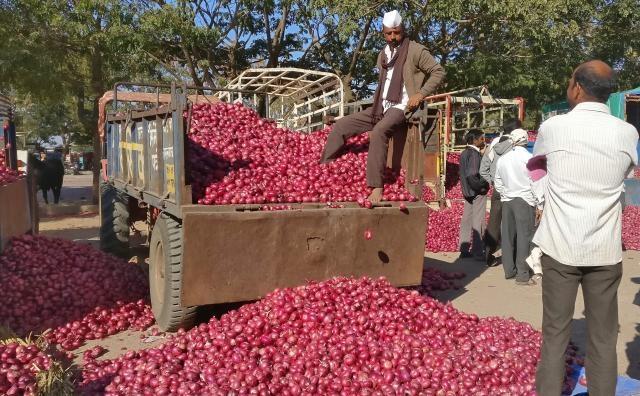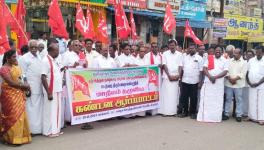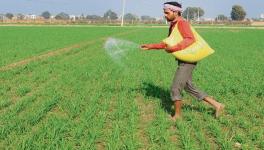Maharashtra Farmers' Shattered Hopes in Onion Fields

Image Coutesy: Reuters
Last week the photo of a farmer lying dead on the onion crop in his farm went viral on social media in Maharashtra, bringing the already deepening crisis of onion price into headlines again. Reactions started pouring in from all corners.
The farmer was thirty-five years old Dnyaneshwar Shivankar, from Kandhare village of Nasik's Malegaon teshil. He had consumed poison as his crop got rotten in his farm shed.
Dnyaneshwar is not alone. Eighteen farmers have committed suicide in the first 20 days of the new year. It shows how deep the crisis is and how farmers have lost faith of any help from the state.
The Onion Farmers’ Crisis
India is witnessing a bumper onion crop this season. Almost 220 lakh tonnes of onion crop have flooded the market, which is around 40 lakh tonnes extra than the country's consumption capacity. This has impacted the rates of onion procurement on ground badly. To get an idea of the onion crisis, we need to understand the cycle of onion prices first.
When the market falls badly, farmers turn to other crop than onions. So, in the next season the rate of onions shoots up to sky. This gives a good amount to the farmers directly. Then, in the next season, large number of farmers again shift to onions. The extra produce results in the falling of prices. And so on. This is the cycle of crisis. Over the last thirty years, this has been happening season after season.
If we look into the rate cards in the last three and half years, we find the same picture. The market has seen rates as low as below Rs. 800 per quintal from December 2015 to July 2017. This was the longest 'down market' of recent time. As a result, farmers turned to another crop in 2017. This resulted into the shooting up of prices from July 2017 to February 2018. This brief period saw the rates going up to Rs. 2,500 per quintal. From February 2018 to January 2019, the rates have been again down and farmers are getting almost negligible price for their crop. According to reports, in few markets, the onion rate has gone down to Rs. 100-150 per quintal.
Also Read: I was Shocked When I got Just Rs 1,064 for 750 kg, Says Nashik Onion Farmer
No other market for any other produce in India has seen such huge ups and downs. In just 18 months, the market has gone from Rs. 800 to Rs. 2,500 per quintal and back to Rs. 150, resulting in chaos. Experts believe that zero planning on the government’s side is the root cause of this crisis.
Government Policies
According to experts, there are number of things that the government could do to help the farmers in getting good prices. "The most important policy could be the 'Bhavantar Scheme'. Government should decide the production cost of onions per kilogram. Suppose if it is Rs. 8 per kg and if farmers are getting just Rs. 3 or 4 then the remaining price should be given to the farmer as allowance. So, that their production costs are evened out and the farmers are not forced to take any extreme step like suicide," suggested Nanasaheb Patil, director of the National Agricultural Cooperative Marketing Federation of India Limited (NAFED).
The inconsistency in the government's export import policy is also hurting Indian farmers in this crisis. There has been extra production of 35 to 40 lakh tonnes per season for the last few years. India needs around 170 lakh tonnes onions annually. The average production is around 215 to 220 lakh tonnes. So, India will have to come up with an export-oriented policy.
If we look at the export, we see the highest export of 34 lakh tonnes onions was in 2016-17. From April to October 2017, 16.79 lakh tonnes were exported worth a value of Rs. 2,475 crore. In the current financial year, from April to October 2018, 12 lakh tonnes onion has been exported worth a value of Rs. 1,791 crore. But this year, Indian exporters had to compete with Pakistani onions. Union government declared a 5 per cent export subsidy in July 2018. Experts believe that, had the government given 10 per cent instead of 5, then the exports would have increased. This increased export would have also balanced the fall in prices of domestic market and that could have averted the current crisis.
Also Read: Maharashtra Government’s Rs. 150 crore Package for Subsidy, A Jumla?
Even though the union government understood the seriousness of increasing the export subsidy, it was too late. In December 2018, it was increased from 5 per cent to 10 per cent. This will be continued till the end of June 2019. It is believed that this would help the export and stabilise the domestic market.
Agitations and Reactions
In the election year, the fall in onion prices has become a serious political issue. To add to that, various farmers' organisations have been agitating against the anti-farmer government policies. The All India Kisan Sabha's Maharashtra general secretary Dr. Ajit Navale blamed the government's attitude for the current crisis. "It is not a problem of plenty. It is a problem of lack of mechanism. The cycle of less onions, higher rates, and huge crops, fallen prices, has been going on for years. This helps only the middlemen. Neither the consumers nor the farmers. So, there should be a mechanism to plan it well and it is the responsibility of the government to do so," said Dr Navale.
Swabhimani Shetkari Sanghathana's leader and Member of Parliament Raju Shetti said that the government is in a bid to keep the middle-class consumer happy even at the cost of killing the farmers. "Per kg production of onion costs Rs. 8. However, farmers are getting Rs. 1 or maximum Rs. 2. In this case, the government should have intervened and given direct subsidy to farmers. Otherwise, it should have taken steps to make the domestic market stronger. But to manage the headlines of consumer inflation below the average, this government is killing the producers. This attitude has literally broken the spine of Indian farmers now," said Shetti.
Meanwhile, back in the field, a farmer, Suresh Karale from village Valan of Rahuri teshil, Ahmednagar district took his sheep to his onion farm. "What else can we do when even after investing over Rs. 60,000 in the onion crop, you get just Rs. 20,000 in return? In this drought, these sheep would help to live instead of this crop. That's why I left them there," said Karale to a local newspaper. In Karale's words, we can sense how the hopes of farmers in the Onion Belt of Maharashtra have been completely shattered.
Read More: Maha Farmers Left Dismayed As Agricultural Produce Prices Crash
Get the latest reports & analysis with people's perspective on Protests, movements & deep analytical videos, discussions of the current affairs in your Telegram app. Subscribe to NewsClick's Telegram channel & get Real-Time updates on stories, as they get published on our website.























